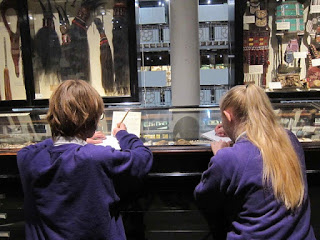Throughout the Autumn term of 2016 we worked with a Key Stage 4 class at Iffley Academy in Oxford on a print-making project inspired by Aboriginal Art in the Pitt Rivers Museum. Iffley Academy is a community Special Academy for children and young people up to the age of 18 with special educational needs. Each of the participating students created an Arts Award Explore portfolio as part of the project. Arts Award Explore is a nationally recognised Entry Level 1 Qualification.
We began the term by meeting each other on skype. The class prepared a series of questions for me (I am the secondary education officer at the Museum) about the Pitt Rivers Museum and what I do here. It was a great chance to ‘e-meet’ each other and talk about what we were going to do in the project before I visited the school for the first time.
We began the term by meeting each other on skype. The class prepared a series of questions for me (I am the secondary education officer at the Museum) about the Pitt Rivers Museum and what I do here. It was a great chance to ‘e-meet’ each other and talk about what we were going to do in the project before I visited the school for the first time.
After that I
visited the school, when I took along a selection of Aboriginal objects from
our handling collection. These included
two boomerangs with painted designs, woven baskets and large reproductions of
some of the beautiful Aboriginal paintings in the collection. We learnt about
how to handle delicate objects carefully, and thought about what these things
were made out of and what they were used for. For example how skilled
Aboriginal basket weavers are and how they make baskets out of natural
materials. We then discovered a bit about Aboriginal culture and painting. We
discovered how ancient Aboriginal culture is, and how many artworks depict
scenes and figures from the Dreaming. The Dreaming is the word outsiders use to
describe the way Aborigines look at the world. It is based upon timeless
stories featuring mythological creatures and ancestors, whose actions resulted
in the creation of the landscape, animals and the Aboriginal people.
Next each student
did a drawing and took a photograph of their favourite object.
 |
Dilly bag made of pandanus fibre,
painted with red ochre
© Pitt Rivers Museum
|
 |
Woven basket made of pandanus fibre
© Pitt Rivers Museum
|
 |
Curved boomerang with painted decoration of a
kangaroo © Pitt Rivers Museum
|
 |
| Replica boomerang with painted decoration of a geko © Pitt Rivers Museum |
Then came the
students’ trip to the museum. It was fantastic to welcome the group here. They
came with so many questions and put their drawing skills to full use. We took a
close look at the Aboriginal paintings and also visited the Conversation studio
and the Education team office.
 |
| Students visiting the colourful Pitt Rivers Education Office © Pitt Rivers Museum |
 |
| Looking at painting by the artist Yirawala, from the Gunwingg community in Northem Arnhem Land. The painting is on bark and is of the Rainbow Snake, done in the 'X-ray style' of painting © Pitt Rivers Museum Painting on canvas by the artist Judy Napangardi Watson, 1994.43.1 © Pitt Rivers Museum |
 |
| Drawing in the Museum © Pitt Rivers Museum |
 |
| Drawing in the Museum © Pitt Rivers Museum |
After the visit
each student created their own poster about the Museum, presenting all their
research so far. Then they chose one of their drawings to turn into a printed
design. After that the textile artist Ellen Love came into school for an
amazing collagraph printing workshop. The students transferred their designs
onto a printing board, then used a special safe cutting knife to mark their
design into the board.
They then built
up textures by cutting aware more cardboard, or adding small pieces of masking
tape. Ellen showed us how to add ink to the board (using gloves!) and then make
sure excess ink was removed using a special piece of muslin cloth called
‘scrim’. Finally it was time to use Ellen’s printing press! Each student made
three prints from their board.
 |
| Inking the board © Pitt Rivers Museum |
 |
| Scrubbing with the 'scrim' to remove excess ink © Pitt Rivers Museum |
 |
| Board ready for printing © Pitt Rivers Museum |
 |
| Placing the board on the collagraph printing press © Pitt Rivers Museum |
 |
| Placing the board on the collagraph printing press © Pitt Rivers Museum |
 |
| Revealing the print © Pitt Rivers Museum |
 |
| Revealing the print © Pitt Rivers Museum |
Once all the
artwork was complete it was time to make a presentation about what we’d learnt
and what we’d made. The students used the excellent ‘Explain Everything’ app to
create a presentation about their learning and artwork. Some of the students
chose also to present to Ellen and me in person.
 |
| Student presenting their project work to their teacher as part of achieving their Arts Award Explore qualification © Pitt Rivers Museum |
A huge well done
to all eleven students for completing their Arts Award portfolios, creating
some truly beautiful work, and for learning about lots of different aspects of
Aboriginal art and culture.
Katherine Rose
Education Officer
(Secondary and FE)
Pitt Rivers
Museum

No comments:
Post a Comment